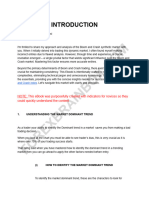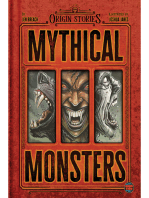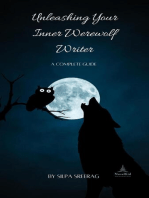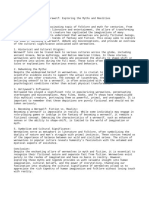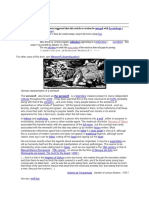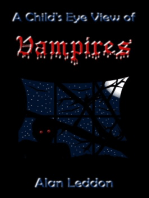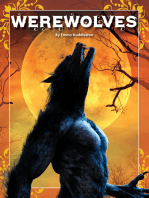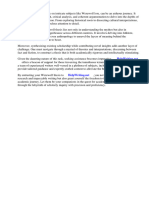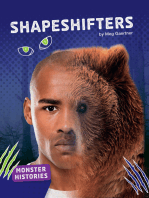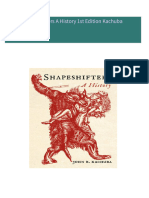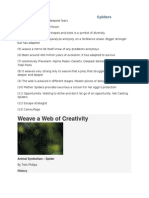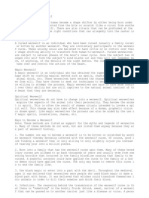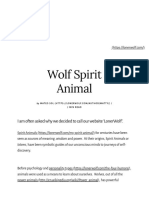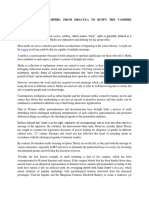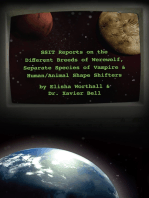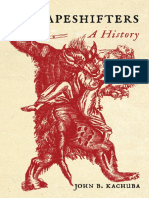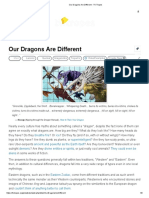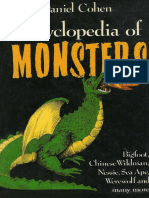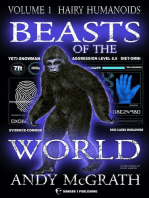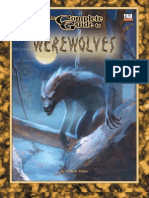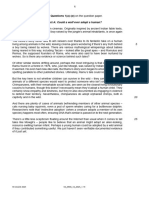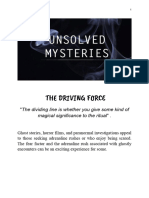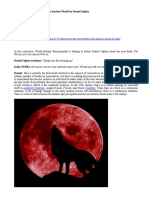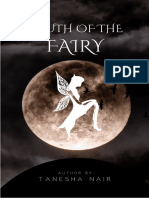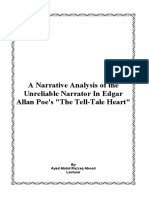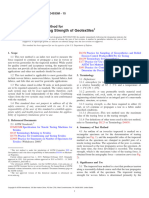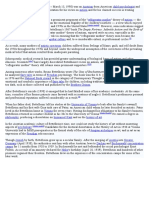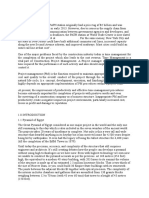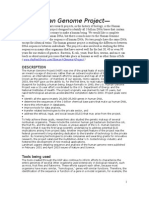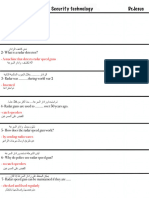English Werewolves
English Werewolves
Uploaded by
poopooCopyright:
Available Formats
English Werewolves
English Werewolves
Uploaded by
poopooCopyright
Available Formats
Share this document
Did you find this document useful?
Is this content inappropriate?
Copyright:
Available Formats
English Werewolves
English Werewolves
Uploaded by
poopooCopyright:
Available Formats
Werewolves
Werewolves, also known as lycanthropes, are mythological
or folkloric humans with the ability to shape-shift into a
hybrid wolf-like creature. They are generally found in
Europe and date from the medieval period. The legend of
the werewolf developed in parallel to the belief in witches
and is still evident in popular culture today.
Appearance
Traditionally, a werewolf is indistinguishable from an ordinary wolf apart from several
features. These are: a larger body, lack of a distinct tail, human eyes and voice. When a
werewolf is in human form, they have tell-tale physical traits including: a monobrow (the
eyebrows meeting in the middle), curved fingernails, low-set ears and a swinging stride.
Shape-shifting ability
Werewolves are humans who transition into wolf-like creatures, either purposefully or after
being placed under a curse. Various methods of becoming a werewolf have been reported. In
folklore, most werewolves originate from being cursed or bitten by another werewolf.
Historically, most werewolves transform under the light of a full moon. Some historical tales
list other stranger methods of transformation, such as: rubbing the body with magic ointment,
drinking rainwater out of the footprint of the animal or repeating a set spell. After returning
to their human form, werewolves are usually documented as becoming weak, debilitated and
undergoing painful, nervous depression.
How dangerous are they?
Often perceived as a threat throughout history, werewolves generally prey on any living
thing; however they particularly target children. Werewolves attack in a variety of ways. The
Scandinavian werewolf is known to possess poison-coated claws. This creature uses its gaze to
paralyse its victims which enables the final blow to be delivered with devastating accuracy.
Some werewolves are known to target the graves of their victims; digging up bodies to
consume to satisfy their cravings.
Modern culture
Even after many centuries of tales, a fascination with werewolves still exists in modern
society. The most popular depiction of a werewolf on film is in the renowned movie franchise:
‘Twilight’. Another work of fiction which mentions these mythical beasts is ‘Harry Potter’.
This series of books features several werewolves (including Remus Lupin).
The fascinating history of werewolves is still enjoyed and studied today thanks to the
reinvention of the mythical beast for each new generation of enthusiasts. The werewolf will
surely continue to frighten, fascinate and strike fear into the hearts of generations to come.
PMS Self-study 2020 Werewolves
Comprehension and vocabulary
1. Write your own definition of a werewolf.
2. According to tradition, how can a werewolf be recognised when it is wolf form? How
can one be recognised when it is in human form?
3. According to folklore, what is the most common way of becoming a werewolf?
4. Give one way in which a Scandinavian werewolf is different to other werewolves.
5. Give two examples of werewolves appearing in modern culture.
6. According to the text, why do people today still study and enjoy the history of
werewolves?
Techniques and effect
7. Look at the paragraph with the sub-heading Appearance. Why do the words, “the
eyebrows meeting in the middle” appear in parentheses?
8. Can you find another example of parenthesis in the text?
9. Who do you think is the intended audience of this text? Why do you think this?
Explain your answer fully, referring to specific examples in the text.
Extended writing
10.Write an informative report about a mythological or legendary creature of your
choice. You could research an existing creature, or make one of your own up. You
should write clearly and in detail, in a formal, impersonal style.
PMS Self-study 2020 Werewolves
You might also like
- CS440-01 R223.1337en Spare Parts CatalogDocument32 pagesCS440-01 R223.1337en Spare Parts CatalogLuis Aguilera S92% (13)
- The Secret of Boom and Crash Trading Sniper EntryDocument22 pagesThe Secret of Boom and Crash Trading Sniper Entryadvancedt24100% (1)
- Encyclopedia of the Undead: A Field Guide to the Creatures That Cannot Rest in PeaceFrom EverandEncyclopedia of the Undead: A Field Guide to the Creatures That Cannot Rest in PeaceRating: 4 out of 5 stars4/5 (13)
- WWF Werewolf Full TextDocument42 pagesWWF Werewolf Full TextMiloshu100% (2)
- Wettstein WerewolfDocument4 pagesWettstein Werewolfeduard_airinei6687No ratings yet
- Operation & Service Manual: Model: 06-4035-3600 Hydraulic Service UnitDocument8 pagesOperation & Service Manual: Model: 06-4035-3600 Hydraulic Service UnitAlejo Guerra FernandezNo ratings yet
- Unleashing Your Inner Werewolf Writer : A complete guideFrom EverandUnleashing Your Inner Werewolf Writer : A complete guideRating: 5 out of 5 stars5/5 (1)
- WerewolfDocument1 pageWerewolfNuxnNAhudPFb6eYSNo ratings yet
- The Werewolf: Past and Future - Lycanthropy's Lost History and Modern DevolutionFrom EverandThe Werewolf: Past and Future - Lycanthropy's Lost History and Modern DevolutionNo ratings yet
- WerewolfDocument10 pagesWerewolfScribdTranslationsNo ratings yet
- Libro de Vampiros y VampirismoDocument23 pagesLibro de Vampiros y VampirismomacielxflavioNo ratings yet
- When Werewolves Attack: A Guide to Dispatching Ravenous Flesh-Ripping BeastsFrom EverandWhen Werewolves Attack: A Guide to Dispatching Ravenous Flesh-Ripping BeastsRating: 3 out of 5 stars3/5 (1)
- The Complete Idiot's Guide to Werewolves: Shed New Light on These Creatures of the NightFrom EverandThe Complete Idiot's Guide to Werewolves: Shed New Light on These Creatures of the NightRating: 3 out of 5 stars3/5 (1)
- Hanging with Vampires: A Totally Factual Field Guide to the SupernaturalFrom EverandHanging with Vampires: A Totally Factual Field Guide to the SupernaturalNo ratings yet
- Werewolves, Shapeshifters, & Skinwalkers - NodrmDocument160 pagesWerewolves, Shapeshifters, & Skinwalkers - NodrmWerewolf67100% (1)
- Vampire Handbook: DR Robert CurranDocument41 pagesVampire Handbook: DR Robert CurranMiloshu100% (4)
- Werewolf ThesisDocument9 pagesWerewolf Thesisbsnj6chr100% (2)
- Beyond Faery: Exploring the World of Mermaids, Kelpies, Goblins & Other Faery BeastsFrom EverandBeyond Faery: Exploring the World of Mermaids, Kelpies, Goblins & Other Faery BeastsNo ratings yet
- LycanthropyDocument14 pagesLycanthropyharukaTsuyoi100% (2)
- Instant Access to Shapeshifters A History 1st Edition Kachuba ebook Full ChaptersDocument67 pagesInstant Access to Shapeshifters A History 1st Edition Kachuba ebook Full Chapterssydnicobia1p100% (1)
- Weave A Web of Creativity: SpidersDocument3 pagesWeave A Web of Creativity: SpidersDevalRajNo ratings yet
- Cryptids, Creatures & Critters: A Manual of Monsters & Mythos from Around the WorldFrom EverandCryptids, Creatures & Critters: A Manual of Monsters & Mythos from Around the WorldNo ratings yet
- The Curse of The Werewolf - (Werewolve/Vampire)Document2 pagesThe Curse of The Werewolf - (Werewolve/Vampire)LuschersUnderworldNo ratings yet
- Wolf Spirit Animal - LonerWolfDocument9 pagesWolf Spirit Animal - LonerWolfDebrup Simongreyman Roy ChowdhuryNo ratings yet
- VampiresDocument13 pagesVampiresamalia9bochisNo ratings yet
- The Complete Idiot's Guide to Vampires: Fascinating Vampire Lore from Eastern Europe, Greece, Italy, and the Middle EastFrom EverandThe Complete Idiot's Guide to Vampires: Fascinating Vampire Lore from Eastern Europe, Greece, Italy, and the Middle EastRating: 3.5 out of 5 stars3.5/5 (9)
- Revamping The Vamp Conference PaperDocument10 pagesRevamping The Vamp Conference PaperHelena BobNo ratings yet
- SSIT Reports on the Different Breeds of Werewolf, Separate Species of Vampire and Human/Animal Shape Shifters By Elisha Worthall and Dr. Xavier BellFrom EverandSSIT Reports on the Different Breeds of Werewolf, Separate Species of Vampire and Human/Animal Shape Shifters By Elisha Worthall and Dr. Xavier BellNo ratings yet
- Unit 7 Time Machine Ion CompleteDocument10 pagesUnit 7 Time Machine Ion CompleteAmrit Singh ChohanNo ratings yet
- Are Werewolves Real AudioDocument2 pagesAre Werewolves Real Audiozalizada762No ratings yet
- ShapeshiftersDocument201 pagesShapeshiftersBruno Joel100% (1)
- Creatures in MythologiesDocument2 pagesCreatures in MythologiesMarc Anthony ManzanoNo ratings yet
- Lesson Text As Connected DiscourseDocument8 pagesLesson Text As Connected Discourseasdaddaae213123eqweNo ratings yet
- Our Dragons Are Different - TV TropesDocument9 pagesOur Dragons Are Different - TV TropesSunshine FrankensteinNo ratings yet
- Encyclopedia of Monsters PDFDocument298 pagesEncyclopedia of Monsters PDFGenaro Huacon80% (15)
- Dreamcatchers, Edens, and Universes: Reflections of a Life in Poems and Short StoriesFrom EverandDreamcatchers, Edens, and Universes: Reflections of a Life in Poems and Short StoriesNo ratings yet
- The Complete Guide To WerewolvesDocument74 pagesThe Complete Guide To Werewolvesapatossauro100% (7)
- How to Write a Bestselling Werewolf Romance: Writing Werewolf Romances That Howl with Success: How to Write a Bestseller Romance Series, #6From EverandHow to Write a Bestselling Werewolf Romance: Writing Werewolf Romances That Howl with Success: How to Write a Bestseller Romance Series, #6No ratings yet
- 03 0500 12 Insert 2024 1 1Document4 pages03 0500 12 Insert 2024 1 1fortn44270% (1)
- Eng Proj JustifiedDocument25 pagesEng Proj Justifiedatchayazhini0410No ratings yet
- Kami Export - Rita Belal Ersan Abu Haija - Giant AntsDocument2 pagesKami Export - Rita Belal Ersan Abu Haija - Giant Ants104414No ratings yet
- Genre Lesson 2Document21 pagesGenre Lesson 2api-215500084No ratings yet
- Fisher Dakota Unit 4 Critical Thinking QuestionsDocument3 pagesFisher Dakota Unit 4 Critical Thinking QuestionsDAKOTA FISHERNo ratings yet
- Furry Fiction is Everywhere: A Step-by-Step Guide to Writing Anthropomorphic CharactersFrom EverandFurry Fiction is Everywhere: A Step-by-Step Guide to Writing Anthropomorphic CharactersNo ratings yet
- Interview. The Werewolf in The Ancient World by Daniel OgdenDocument6 pagesInterview. The Werewolf in The Ancient World by Daniel OgdenBogdanNo ratings yet
- A Study of Dragons of Eastern Europe: Spirits & Creatures Series, #3From EverandA Study of Dragons of Eastern Europe: Spirits & Creatures Series, #3Rating: 3 out of 5 stars3/5 (2)
- The Evil FairyDocument17 pagesThe Evil FairyTanesha Nair100% (1)
- Illustrated Parts Catalog FOR E-165, E-185 & E-225 Aircraft EnginesDocument42 pagesIllustrated Parts Catalog FOR E-165, E-185 & E-225 Aircraft Enginesr4airsalvageNo ratings yet
- Body ShopDocument6 pagesBody Shopannush17No ratings yet
- Wolayita Sodo Project AR Design Bid ToR - 230221 - 144559Document20 pagesWolayita Sodo Project AR Design Bid ToR - 230221 - 144559Yemesrach MeleseNo ratings yet
- The Myth of Daedalus and IcarusDocument3 pagesThe Myth of Daedalus and IcarusMildred Abad SarmientoNo ratings yet
- .archivetempSIS 1037Y Tutorial 3Document2 pages.archivetempSIS 1037Y Tutorial 3Ishika GNo ratings yet
- Overhaul: - Vane Pump AssyDocument7 pagesOverhaul: - Vane Pump AssyRomy MNo ratings yet
- A Narrative Analysis of The Unreliable Narrator in Edgar Allan Poe's "The Tell-Tale Heart"Document16 pagesA Narrative Analysis of The Unreliable Narrator in Edgar Allan Poe's "The Tell-Tale Heart"Alejandro González MedinaNo ratings yet
- Lecture 2-3 Hawthorne Case Studies - DesignDocument20 pagesLecture 2-3 Hawthorne Case Studies - DesignArjan ChatterjeeNo ratings yet
- Astm D4533D4533M-15Document6 pagesAstm D4533D4533M-15Sandra LopesNo ratings yet
- Miran Mcertificates PDFDocument19 pagesMiran Mcertificates PDFMIRAN KADRINo ratings yet
- Theory of Organizational Culture and EffectivenessDocument21 pagesTheory of Organizational Culture and Effectivenessmwananzambi1850No ratings yet
- Nadcap Customer Support Initiative (NCSI) For NewcomersDocument94 pagesNadcap Customer Support Initiative (NCSI) For NewcomersAli Mohsin100% (2)
- November RevitionDocument3 pagesNovember RevitionRokaya fouadNo ratings yet
- Ts 5 Usbc 402Document29 pagesTs 5 Usbc 402German Ahumada ArancibiaNo ratings yet
- L1 Solution Deck For SAP S4 HANA RetailDocument17 pagesL1 Solution Deck For SAP S4 HANA RetailbupeshNo ratings yet
- Typical Deck DetailsDocument20 pagesTypical Deck Detailskohatian27796105100% (1)
- International Accounting Standard With ExamplesDocument15 pagesInternational Accounting Standard With ExamplesAmna MirzaNo ratings yet
- G481 Module 2 Forces in Action QuestionsDocument13 pagesG481 Module 2 Forces in Action QuestionsAmberNo ratings yet
- A Study On Employee Retention in Rane Madras LTD, Chennai: Submitted byDocument76 pagesA Study On Employee Retention in Rane Madras LTD, Chennai: Submitted byJasmin RaichelNo ratings yet
- Annual Report: of The Secretariat of The Pacific Regional Environment ProgrammeDocument52 pagesAnnual Report: of The Secretariat of The Pacific Regional Environment ProgrammeDavid BriggsNo ratings yet
- The Art of Moving PicturesDocument1 pageThe Art of Moving PicturesarunbdhNo ratings yet
- Average Time Middle Schoolers Spend On HomeworkDocument5 pagesAverage Time Middle Schoolers Spend On Homeworkafetuieog100% (1)
- The Great PyramidDocument10 pagesThe Great PyramidRajendiraperasad ManiamNo ratings yet
- The Human Genome Project-: DescriptionDocument8 pagesThe Human Genome Project-: Descriptionmodeesa_aliNo ratings yet
- قطعة (Unit 2) الرادارDocument4 pagesقطعة (Unit 2) الرادارaaaeee1114890No ratings yet
- Ameena Muzaffar - Ad Analysis Essay Final DraftDocument3 pagesAmeena Muzaffar - Ad Analysis Essay Final Draftapi-523266725No ratings yet
- Equipment Storage ProcedureDocument3 pagesEquipment Storage ProcedureJuan Pablo Chavez IxtepanNo ratings yet

